First Canadian Army on:
[Wikipedia]
[Google]
[Amazon]
The First Canadian Army (french: 1reArmée canadienne) was a
"First Canadian Army"
The Canadian Encyclopedia. Historica Foundation. Retrieved on: 2011-12-23 The First Canadian Army's strength was 177,000 all ranks at the end of 1942. One year later it had grown to 242,000. On 31 May 1944, shortly before the
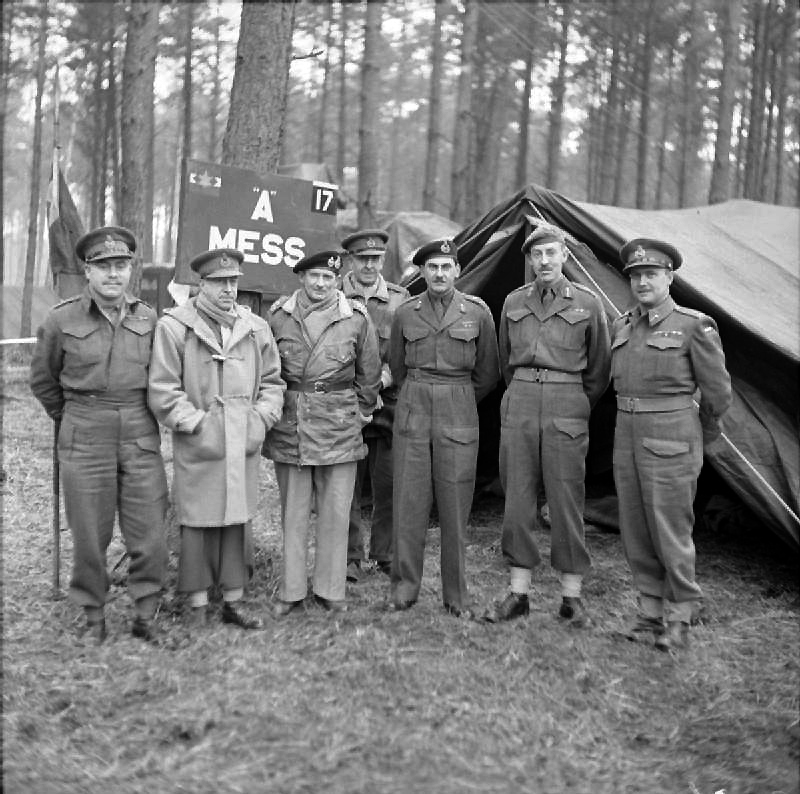 When the First Canadian Army was formed overseas in 1942,
When the First Canadian Army was formed overseas in 1942, 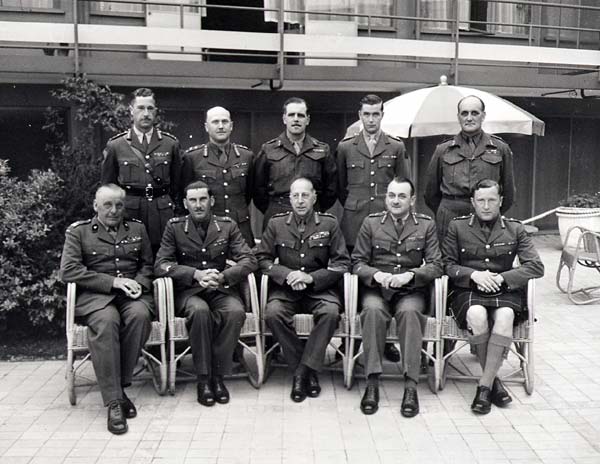 The Army proper first went into action in the
The Army proper first went into action in the
 First Canadian Army
**Headquarters
***First Canadian Army Defence Battalion - Lorne Scots (until April 1944) &
First Canadian Army
**Headquarters
***First Canadian Army Defence Battalion - Lorne Scots (until April 1944) & 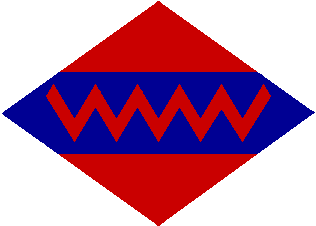 No. 1 Army Group, R.C.A.(1st Cdn AGRA)
****11th Army Field Regiment
****
No. 1 Army Group, R.C.A.(1st Cdn AGRA)
****11th Army Field Regiment
**** No. 2 Army Group, R.C.A.(2nd Cdn AGRA)
****19th Army Field Regiment
**** 3rd Medium Regiment, Royal Canadian Artillery
****
No. 2 Army Group, R.C.A.(2nd Cdn AGRA)
****19th Army Field Regiment
**** 3rd Medium Regiment, Royal Canadian Artillery
****


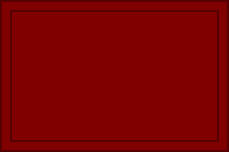 5th Canadian Armoured Division
***
5th Canadian Armoured Division
*** 1st Canadian Armoured Brigade
*** 1st Corps Defence Company (Lorne Scots)
***Other Corps Troops
**
1st Canadian Armoured Brigade
*** 1st Corps Defence Company (Lorne Scots)
***Other Corps Troops
**
 2nd Canadian Infantry Division
***
2nd Canadian Infantry Division
*** 3rd Canadian Infantry Division
***
3rd Canadian Infantry Division
*** 4th Canadian Armoured Division
***
4th Canadian Armoured Division
***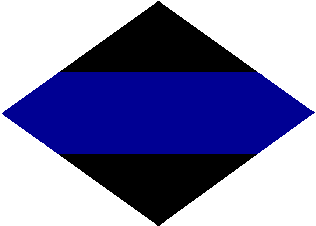 2nd Canadian Armoured Brigade
***
2nd Canadian Armoured Brigade
***






 33rd Armoured Brigade (to September 1944)
***
33rd Armoured Brigade (to September 1944)
*** 104th Infantry Division (United States) (mid October to early November, 1944)
**
104th Infantry Division (United States) (mid October to early November, 1944)
** XXX British Corps (January to March, 1945 for
XXX British Corps (January to March, 1945 for 
 43rd (Wessex) Infantry Division
***
43rd (Wessex) Infantry Division
***
 53rd (Welsh) Infantry Division
***
53rd (Welsh) Infantry Division
*** elements of
elements of  4th Armoured Brigade
***
4th Armoured Brigade
*** 6th Guards Armoured Brigade
***
6th Guards Armoured Brigade
*** 8th Armoured Brigade
***
8th Armoured Brigade
*** 34th Armoured Brigade
34th Armoured Brigade
The Canadian Army, 1939–1945 : An Official Historical Summary
King's Printer, Ottawa (Downloadable PDF) * Stacey, C P. (1955
Official History of the Canadian Army in the Second World War, Vol I Six Years of War
Queen's Printer, Ottawa (Downloadable PDF) * Stacey, C P. (1956)
Official history of the Canadian Army in the Second World War, Vol II The Canadians in Italy
Queen's Printer, Ottawa (Downloadable PDF) * Stacey, C P. (1960
Official History of the Canadian Army in the Second World War, Vol III The Victory Campaign: The Operations in Northwest Europe, 1944–45
Queen's Printer, Ottawa (Downloadable PDF)
The First Canadian Army
– Veterans Affairs Canada
– Juno Beach Centre {{Canadian Forces Land Force Command, state=collapsed 01 Army Military units and formations of the Canadian Army 1942 establishments in Canada 1946 disestablishments in Canada Canadian Army 01 Canadian Army 01
field army
A field army (or numbered army or simply army) is a military formation in many armed forces, composed of two or more corps and may be subordinate to an army group. Likewise, air armies are equivalent formation within some air forces, and with ...
and a formation of the Canadian Army in World War II
World War II or the Second World War, often abbreviated as WWII or WW2, was a world war that lasted from 1939 to 1945. It involved the vast majority of the world's countries—including all of the great powers—forming two opposin ...
in which most Canadian
Canadians (french: Canadiens) are people identified with the country of Canada. This connection may be residential, legal, historical or cultural. For most Canadians, many (or all) of these connections exist and are collectively the source of ...
elements serving in North-West Europe
Northwestern Europe, or Northwest Europe, is a loosely defined subregion of Europe, overlapping Northern and Western Europe. The region can be defined both geographically and ethnographically.
Geographic definitions
Geographically, Northwe ...
were assigned. It served on the Western Front from July 1944 until May 1945.
The army was formed in early 1942, replacing the existing unnumbered Canadian Corps
The Canadian Corps was a World War I corps formed from the Canadian Expeditionary Force in September 1915 after the arrival of the 2nd Canadian Division in France. The corps was expanded by the addition of the 3rd Canadian Division in December ...
, as the growing contribution of Canadian forces to serve with the British Army in the United Kingdom
The United Kingdom of Great Britain and Northern Ireland, commonly known as the United Kingdom (UK) or Britain, is a country in Europe, off the north-western coast of the continental mainland. It comprises England, Scotland, Wales and North ...
necessitated an expansion to two corps
Corps (; plural ''corps'' ; from French , from the Latin "body") is a term used for several different kinds of organization. A military innovation by Napoleon I, the formation was first named as such in 1805. The size of a corps varies great ...
. By the end of 1943 Canadian formations consisted of three infantry
Infantry is a military specialization which engages in ground combat on foot. Infantry generally consists of light infantry, mountain infantry, motorized infantry & mechanized infantry, airborne infantry, air assault infantry, and marine i ...
division
Division or divider may refer to:
Mathematics
*Division (mathematics), the inverse of multiplication
*Division algorithm, a method for computing the result of mathematical division
Military
*Division (military), a formation typically consisting ...
s, two armoured
Armour (British English) or armor (American English; see spelling differences) is a covering used to protect an object, individual, or vehicle from physical injury or damage, especially direct contact weapons or projectiles during combat, or f ...
divisions and two independent armoured brigade
A brigade is a major tactical military formation that typically comprises three to six battalions plus supporting elements. It is roughly equivalent to an enlarged or reinforced regiment. Two or more brigades may constitute a division.
Br ...
s. The first commander was Lieutenant-General
Lieutenant general (Lt Gen, LTG and similar) is a three-star military rank (NATO code OF-8) used in many countries. The rank traces its origins to the Middle Ages, where the title of lieutenant general was held by the second-in-command on the ...
A. G. L. "Andy" McNaughton, who was replaced in 1944 by General
A general officer is an Officer (armed forces), officer of highest military ranks, high rank in the army, armies, and in some nations' air forces, space forces, and marines or naval infantry.
In some usages the term "general officer" refers t ...
H. D. G. "Harry" Crerar. Both had been senior Royal Regiment of Canadian Artillery
, colors = The guns of the RCA themselves
, colors_label = Colours
, march = * Slow march: "Royal Artillery Slow March"
* Quick march (dismounted parades): "British Grenadiers/ The ...
officer
An officer is a person who has a position of authority in a hierarchical organization. The term derives from Old French ''oficier'' "officer, official" (early 14c., Modern French ''officier''), from Medieval Latin ''officiarius'' "an officer," f ...
s in the Canadian Corps
The Canadian Corps was a World War I corps formed from the Canadian Expeditionary Force in September 1915 after the arrival of the 2nd Canadian Division in France. The corps was expanded by the addition of the 3rd Canadian Division in December ...
in the Great War
World War I (28 July 1914 11 November 1918), often abbreviated as WWI, was one of the deadliest global conflicts in history. Belligerents included much of Europe, the Russian Empire, the United States, and the Ottoman Empire, with fightin ...
. Allied
An alliance is a relationship among people, groups, or states that have joined together for mutual benefit or to achieve some common purpose, whether or not explicit agreement has been worked out among them. Members of an alliance are called ...
formations of other nationalities were added to the First Canadian Army to keep it at full strength.Harris, Stephen"First Canadian Army"
The Canadian Encyclopedia. Historica Foundation. Retrieved on: 2011-12-23 The First Canadian Army's strength was 177,000 all ranks at the end of 1942. One year later it had grown to 242,000. On 31 May 1944, shortly before the
Normandy landings
The Normandy landings were the landing operations and associated airborne operations on Tuesday, 6 June 1944 of the Allied invasion of Normandy in Operation Overlord during World War II. Codenamed Operation Neptune and often referred to as ...
, Canadian troops in Europe numbered 251,000 of which 75,000 had left First Canadian Army to serve on the Italian Front.
History
 When the First Canadian Army was formed overseas in 1942,
When the First Canadian Army was formed overseas in 1942, Lieutenant-General
Lieutenant general (Lt Gen, LTG and similar) is a three-star military rank (NATO code OF-8) used in many countries. The rank traces its origins to the Middle Ages, where the title of lieutenant general was held by the second-in-command on the ...
Andrew McNaughton
Andrew is the English form of a given name common in many countries. In the 1990s, it was among the top ten most popular names given to boys in English-speaking countries. "Andrew" is frequently shortened to "Andy" or "Drew". The word is derived ...
's aim was to keep Canada's contributions to the British Army together to lead the cross-channel assault on northwest Europe. Two brigades of the 2nd Canadian Division led the ill-fated Dieppe Raid
Operation Jubilee or the Dieppe Raid (19 August 1942) was an Allied amphibious attack on the German-occupied port of Dieppe in northern France, during the Second World War. Over 6,050 infantry, predominantly Canadian, supported by a regiment o ...
in 1942. Aside from this endeavour, the Army did not see combat until July 1943. In 1943, because the Canadian government wanted Canadian troops to see action immediately, the 1st Canadian Infantry Division
The 1st Canadian Division (French: ''1re Division du Canada'' ) is a joint operational command and control formation based at CFB Kingston, and falls under Canadian Joint Operations Command. It is a high-readiness unit, able to move on very short ...
, 1st Canadian Armoured Brigade, and 5th Canadian Armoured Division were detached from the Army for participation in the Italian Campaign.
In early 1944, the 3rd Canadian Infantry Division and 2nd Canadian Armoured Brigade were also detached to British I Corps to participate in the assault phase of the Normandy landings
The Normandy landings were the landing operations and associated airborne operations on Tuesday, 6 June 1944 of the Allied invasion of Normandy in Operation Overlord during World War II. Codenamed Operation Neptune and often referred to as ...
. II Canadian Corps
II Canadian Corps was a corps-level formation that, along with I (British) Corps (August 1, 1944 to April 1, 1945) and I Canadian Corps (April 6, 1943 to November 1943, and April 1, 1945 until the end of hostilities), comprised the First Canad ...
became operational in Normandy in early July 1944, as the 2nd Canadian Infantry Division landed. The First Canadian Army headquarters did not itself arrive in Normandy until mid-July, becoming operational 23 July 1944 just prior to 4th Canadian Armoured Division arriving on the Continent.
 The Army proper first went into action in the
The Army proper first went into action in the Battle of Normandy
Operation Overlord was the codename for the Battle of Normandy, the Allied operation that launched the successful invasion of German-occupied Western Europe during World War II. The operation was launched on 6 June 1944 (D-Day) with the Norma ...
and conducted operations at Falaise
Falaise may refer to:
Places
* Falaise, Ardennes, France
* Falaise, Calvados, France
** The Falaise pocket was the site of a battle in the Second World War
* La Falaise, in the Yvelines ''département'', France
* The Falaise escarpment in Quebe ...
(e.g. Operation Totalize
Operation Totalize (also spelled Operation Totalise in recent British sources) was an offensive launched by Allied troops in the First Canadian Army during the later stages of Operation Overlord, from 8 to 9 August 1944. The intention was to bre ...
, Operation Tractable
Operation Tractable was the final attack conducted by Canadian and Polish troops, supported by a British tank brigade, during the Battle of Normandy during World War II. The operation was to capture the tactically important French town of Fal ...
) and helping close the Falaise pocket. After reaching the Seine, the objective of the first phase of Operation Overlord, the Army moved along the coast towards Belgium
Belgium, ; french: Belgique ; german: Belgien officially the Kingdom of Belgium, is a country in Northwestern Europe. The country is bordered by the Netherlands to the north, Germany to the east, Luxembourg to the southeast, France to th ...
, with the Canadian 2nd Division entering Dieppe
Dieppe (; Norman: ''Dgieppe'') is a coastal commune in the Seine-Maritime department in the Normandy region of northern France.
Dieppe is a seaport on the English Channel at the mouth of the river Arques. A regular ferry service runs to Newha ...
at the beginning of September. The First Army, under acting command of Lieutenant-General Guy Simonds
Lieutenant-General Guy Granville Simonds, (April 23, 1903 – May 15, 1974) was a senior Canadian Army officer who served with distinction during World War II. Acknowledged by many military historians and senior commanders, among them Sir Max Has ...
(from 28 September 1944 to 7 November 1944), fought the critical Battle of the Scheldt
The Battle of the Scheldt in World War II was a series of military operations led by the First Canadian Army, with Polish and British units attached, to open up the shipping route to Antwerp so that its port could be used to supply the Allies ...
along with the supporting Operation Pheasant
Operation Pheasant, also known as the Liberation of North Brabant, was a major operation to clear German troops from the province of North Brabant in the Netherlands during the fighting on the Western Front in the Second World War. This offensiv ...
in October and early November, opening Antwerp
Antwerp (; nl, Antwerpen ; french: Anvers ; es, Amberes) is the largest city in Belgium by area at and the capital of Antwerp Province in the Flemish Region. With a population of 520,504,
for Allied shipping.
The First Canadian Army held a static line along the river Meuse
The Meuse ( , , , ; wa, Moûze ) or Maas ( , ; li, Maos or ) is a major European river, rising in France and flowing through Belgium and the Netherlands before draining into the North Sea from the Rhine–Meuse–Scheldt delta. It has a ...
(Maas) from December through February, then launched Operation Veritable
Operation Veritable (also known as the Battle of the Reichswald) was the northern part of an Allies of World War II, Allied pincer movement that took place between 8 February and 11 March 1945 during the final stages of the World War II, Second ...
in early February. By this point the Army, besides the II Canadian Corps, contained nine British divisions. The Siegfried Line
The Siegfried Line, known in German as the ''Westwall'', was a German defensive line built during the 1930s (started 1936) opposite the French Maginot Line. It stretched more than ; from Kleve on the border with the Netherlands, along the west ...
was broken and the Army reached the banks of the Rhine
), Surselva, Graubünden, Switzerland
, source1_coordinates=
, source1_elevation =
, source2 = Rein Posteriur/Hinterrhein
, source2_location = Paradies Glacier, Graubünden, Switzerland
, source2_coordinates=
, so ...
in early March.
In the final weeks of the war in Europe, the First Army cleared the Netherlands
)
, anthem = ( en, "William of Nassau")
, image_map =
, map_caption =
, subdivision_type = Sovereign state
, subdivision_name = Kingdom of the Netherlands
, established_title = Before independence
, established_date = Spanish Netherl ...
of German forces. By this time the First Division and Fifth (Armoured) Division as well as First Armoured Brigade and the 1st Cdn AGRA had returned to the Army during Operation Goldflake Operation Goldflake was the administrative move of I Canadian Corps (in essence, all Canadian combatant units) and the British 5th Infantry Division from Italy to Northwestern Europe during the Second World War. British-led forces had been fightin ...
and for the first time, both the I Canadian Corps
I Canadian Corps was one of the two corps fielded by the Canadian Army during the Second World War.
History
From December 24, 1940, until the formation of the First Canadian Army in April 1942, there was a single unnumbered Canadian Corps. I C ...
and II Canadian Corps fought under the same Army commander.
Makeup
The First Canadian Army was international in character. The size of Canada's military contribution on its own would likely not have justified the creation of a separate army-level command in North-West Europe, especially over the period whenI Canadian Corps
I Canadian Corps was one of the two corps fielded by the Canadian Army during the Second World War.
History
From December 24, 1940, until the formation of the First Canadian Army in April 1942, there was a single unnumbered Canadian Corps. I C ...
was away gaining valuable combat experience in Italy. However, both McNaughton and Crerar, backed up by the Canadian government, were successful in their lobbying for the British Army to create a Canadian-led army enlarged with contributions from other Allied countries. In addition to II Canadian Corps
II Canadian Corps was a corps-level formation that, along with I (British) Corps (August 1, 1944 to April 1, 1945) and I Canadian Corps (April 6, 1943 to November 1943, and April 1, 1945 until the end of hostilities), comprised the First Canad ...
(which included the Canadian formations under command described above), other formations under command included the British I Corps, and the 1st Polish Armoured Division
The Polish 1st Armoured Division (Polish ''1 Dywizja Pancerna'') was an armoured division of the Polish Armed Forces in the West during World War II. Created in February 1942 at Duns in Scotland, it was commanded by Major General Stanisław Macze ...
, as well as, at various times, the American 104th Infantry Division (Timberwolf), 1st Belgian Infantry Brigade
The Independent Belgian Brigade was a Belgian and Luxembourg military unit in the Free Belgian forces during World War II, commonly known as the Piron Brigade (''Brigade Piron'') after its commanding officer Jean-Baptiste Piron. It saw action ...
, Royal Netherlands Motorized Infantry Brigade
During the Second World War, the Royal Netherlands Motorized Infantry Brigade, later known as the Princess Irene Brigade ( nl, Prinses Irene Brigade) was a Dutch military unit initially formed from approximately 1,500 troops, including a small gro ...
and 1st Czechoslovak Armoured Brigade. The First Canadian Army in North-West Europe during the final phases of the war comprised the largest field army ever under the control of a Canadian general. Ration strength of the army ranged from approximately 105,000 to 175,000 Canadian soldiers to anywhere from 200,000 to over 450,000 when including the soldiers from other nations.
The 'Maple Leaf Route' was the designation of the army's main supply route
A main supply route (MSR) is the route or routes designated within an area of operations upon which the bulk of traffic flows in support of military operations and humanitarian operations. MSR is a term that is also used in insurgency and irregul ...
. The route was usually divided into Maple Leaf Up and Maple Leaf Down, designating traffic to and away from the front, respectively.
Order of battle
Second World War 1939–1945 *Royal Montreal Regiment
The Royal Montreal Regiment is a Primary Reserve infantry regiment of the Canadian Army based in Westmount, Quebec. It is part of the 2nd Canadian Division's 34 Canadian Brigade Group.
Lineage
File:RMR Colour.jpg, The regimental colour of The R ...
***No. 1 Army Headquarters Car Company, Royal Canadian Army Service Corps
The Royal Canadian Army Service Corps (RCASC) was an administrative and transport corps of the Canadian Army.
The Canadian Army Service Corps was established in the Non-Permanent Active Militia in 1901 and in the Permanent Active Militia in 1903. ...
(RCASC)
**Royal Canadian Artillery
, colors = The guns of the RCA themselves
, colors_label = Colours
, march = * Slow march: "Royal Artillery Slow March"
* Quick march (dismounted parades): "British Grenadiers/The ...
*** No. 1 Army Group, R.C.A.(1st Cdn AGRA)
****11th Army Field Regiment
****
No. 1 Army Group, R.C.A.(1st Cdn AGRA)
****11th Army Field Regiment
****1st Medium Regiment, Royal Canadian Artillery
The 1st Medium Regiment, Royal Canadian Artillery was one of six Canadian medium artillery regiments that served in the European Theatre of World War II. Medium regiments were armed with 5.5-inch and 4.5-inch guns.
History
The adjutant of the 1st ...
**** 2nd Medium Regiment, Royal Canadian Artillery
****5th Medium Regiment, Royal Canadian Artillery
The 5th Medium Regiment, Royal Canadian Artillery, was one of six Canadian medium regiments that saw service in Britain and continental Europe in the Second World War, the others being the 1st, 2nd, 3rd, 4th, and 7th Medium Regiments. (There ...
**** 56th Heavy Regiment, Royal Artillery (from Mar 1945)
*** No. 2 Army Group, R.C.A.(2nd Cdn AGRA)
****19th Army Field Regiment
**** 3rd Medium Regiment, Royal Canadian Artillery
****
No. 2 Army Group, R.C.A.(2nd Cdn AGRA)
****19th Army Field Regiment
**** 3rd Medium Regiment, Royal Canadian Artillery
****4th Medium Regiment, Royal Canadian Artillery
Fourth or the fourth may refer to:
* the ordinal form of the number 4
* ''Fourth'' (album), by Soft Machine, 1971
* Fourth (angle), an ancient astronomical subdivision
* Fourth (music), a musical interval
* ''The Fourth'' (1972 film), a Sovie ...
****7th Medium Regiment, Royal Canadian Artillery
The 7th Medium Regiment, Royal Canadian Artillery, was one of six Canadian medium regiments that saw
service in Britain and continental Europe in the Second World War, the others
being the 1st, 2nd, 3rd, 4th, and 5th Medium Regiments.
(There ...
**** 10th Medium Regiment, Royal Artillery
**** 15th Medium Regiment, Royal Artillery, (disb Dec 44)
**** 1st Heavy Regiment, Royal Artillery
****2nd Heavy Anti-Aircraft Regiment (Mobile)
****1st Rocket Battery
****1st Radar Battery
**"F" Squadron, 25th Armoured Delivery Regiment (The Elgin Regiment), Canadian Armoured Corps
The Royal Canadian Armoured Corps (RCAC; french: links=no, Corps blindé royal canadien) is the armoured corps within the Canadian Army, including 3 Regular and 18 Reserve Force regimentsThe Regiments and Corps of the Canadian Army (Queen's Printe ...
(CAC)
**1st Armoured Personnel Carrier Regiment, CAC
**No. 6 Casualty Clearing Station, Royal Canadian Army Medical Corps
The Royal Canadian Army Medical Corps (RCAMC) was an administrative corps of the Canadian Army.
The Militia Medical Service was established in 1898. It consisted of an Army Medical Service (officers) and an Army Medical Corps (other ranks). ...
(RCAMC)
**Nos. 4, 5, 6 & 7 Field Transfusion Units, RCAMC
**Nos. 9, 10 & 11 Field Dressing Stations, RCAMC
**No. 14 Field Hygiene Section, RCAMC
**units of the Canadian Dental Corps
The Royal Canadian Dental Corps (RCDC, french: links=no, Corps dentaire royal canadien) is a personnel branch of the Canadian Armed Forces (CAF). Most members of RCDC, along with the members of the Royal Canadian Medical Service, are employed in ...
(CDC)
**Nos. 81 & 82 Artillery Companies, RCASC
**Nos. 35 & 36 Army Troops Composite Companies, RCASC
**Nos. 41, 45, 47, 63 & 64 Army Transport Companies, RCASC
**Nos. 1 & 2 Motor Ambulance Convoys, RCASC
**
Royal Canadian Engineers
The Canadian Military Engineers (CME; french: links=no, Génie militaire canadien) is the military engineering personnel branch of the Canadian Armed Forces. The members of the branch that wear army uniform comprise the Corps of Royal Canadian Engi ...
***First Canadian Army Troops Engineers
****10th Field Park Company
****5th, 20th & 23rd Field Companies
***2nd Canadian Army Troops Engineers
****11th Field Park Company
****32nd, 33rd & 34th Field Companies
***No. 1 Workshop and Park Company
***1st Field (Air) Survey Company
***2nd Field Survey Company
***3rd Field (Reproduction) Company
**First Army Signals, Royal Canadian Corps of Signals
The Royal Canadian Corps of Signals (RCCS or RC Sigs; french: links=no, Corps des transmissions royal du Canada, CTRC) is a component within the Canadian Armed Forces' Communications and Electronics Branch, consisting of all members of that person ...
(RCCS)
**1st Air Support Signals Unit
**Nos. 1, 2 & 3 Special Wireless Sections
**First Army Troops Workshop, Royal Canadian Electrical and Mechanical Engineers
The Corps of Royal Canadian Electrical and Mechanical Engineers (RCEME) (french: links=no, Corps du génie électrique et mécanique royal canadien) is a personnel branch of the Canadian Armed Forces (CF) that provides army engineering maintenance ...
**No. 11 Provost Company, Canadian Provost Corps
The Canadian Provost Corps (C Pro C) was the military police corps of the Canadian Army. The Canadian Provost Corps was authorized on 15 June 1940. The Canadian Provost Corps was amalgamated with the police forces of the Royal Canadian Navy and R ...
**No. 1 Canadian Forestry Group, Canadian Forestry Corps
The Canadian Forestry Corps (''Corps forestier canadien'' in French) was an administrative corps of the Canadian Army with its own cap badge, and other insignia and traditions.
The Canadian Forestry Corps was created 14 Nov 1916. The badge of t ...
**No. 1 Army Base Post Office, Canadian Postal Corps
**I Canadian Corps
I Canadian Corps was one of the two corps fielded by the Canadian Army during the Second World War.
History
From December 24, 1940, until the formation of the First Canadian Army in April 1942, there was a single unnumbered Canadian Corps. I C ...
(April 1942 to November 1943; February 1945 to July 1945)
***(attached to the British Eighth Army
The Eighth Army was an Allied field army formation of the British Army during the Second World War, fighting in the North African and Italian campaigns. Units came from Australia, British India, Canada, Czechoslovakia, Free French Forces ...
in Italy from November 1943 to February 1945)
***1st Canadian Infantry Division
The 1st Canadian Division (French: ''1re Division du Canada'' ) is a joint operational command and control formation based at CFB Kingston, and falls under Canadian Joint Operations Command. It is a high-readiness unit, able to move on very short ...
(in Italy from July 1943 to February 1945)
*** 5th Canadian Armoured Division
***
5th Canadian Armoured Division
*** 1st Canadian Armoured Brigade
*** 1st Corps Defence Company (Lorne Scots)
***Other Corps Troops
**
1st Canadian Armoured Brigade
*** 1st Corps Defence Company (Lorne Scots)
***Other Corps Troops
**II Canadian Corps
II Canadian Corps was a corps-level formation that, along with I (British) Corps (August 1, 1944 to April 1, 1945) and I Canadian Corps (April 6, 1943 to November 1943, and April 1, 1945 until the end of hostilities), comprised the First Canad ...
(January 15, 1943 to June 25, 1945)
*** 3rd Canadian Infantry Division
***
3rd Canadian Infantry Division
*** 2nd Canadian Armoured Brigade
***
2nd Canadian Armoured Brigade
***
Polish 1st Armoured Division
The Polish 1st Armoured Division (Polish ''1 Dywizja Pancerna'') was an armoured division of the Polish Armed Forces in the West during World War II. Created in February 1942 at Duns in Scotland, it was commanded by Major General Stanisław Macze ...
***
15th (Scottish) Infantry Division
The 15th (Scottish) Infantry Division was an infantry division of the British Army that served during the Second World War. It was raised on 2 September 1939, the day before war was declared, as part of the Territorial Army (TA) and served in ...
(January to March, 1945)
*** 2nd Corps Defence Company (The Prince Edward Island Light Horse)
***Other Corps Troops
** I British Corps
I, or i, is the ninth letter and the third vowel letter of the Latin alphabet, used in the modern English alphabet, the alphabets of other western European languages and others worldwide. Its name in English is ''i'' (pronounced ), plural ...
(August 1, 1944 to April 1, 1945)
***6th Airborne Division
The 6th Airborne Division was an airborne infantry division of the British Army during the Second World War. Despite its name, the 6th was actually the second of two airborne divisions raised by the British Army during the war, the other being t ...
(to 3 September 1944)
****
1st Belgian Infantry Brigade
The Independent Belgian Brigade was a Belgian and Luxembourg military unit in the Free Belgian forces during World War II, commonly known as the Piron Brigade (''Brigade Piron'') after its commanding officer Jean-Baptiste Piron. It saw action ...
(August 10, 1944 to September 10, 1944)
***
49th (West Riding) Infantry Division
The 49th (West Riding) Infantry Division was an infantry division of the British Army. The division fought in the First World War in the trenches of the Western Front, in the fields of France and Flanders. During the Second World War, the divis ...
***51st (Highland) Infantry Division
The 51st (Highland) Division was an infantry division of the British Army that fought on the Western Front in France during the First World War from 1915 to 1918. The division was raised in 1908, upon the creation of the Territorial Force, as ...
(to 19 December 1944)
*** XXX British Corps (January to March, 1945 for
XXX British Corps (January to March, 1945 for Operation Veritable
Operation Veritable (also known as the Battle of the Reichswald) was the northern part of an Allies of World War II, Allied pincer movement that took place between 8 February and 11 March 1945 during the final stages of the World War II, Second ...
)
***Guards Armoured Division
The Guards Armoured Division was an armoured division of the British Army during the Second World War. The division was created in the United Kingdom on 17 June 1941 during the Second World War from elements of the Guards units, the Grenadier G ...
***52nd (Lowland) Infantry Division
The 52nd (Lowland) Infantry Division was an infantry division of the British Army that was originally formed as the Lowland Division, in 1908 as part of the Territorial Force. It later became the 52nd (Lowland) Division in 1915. The 52nd (Lowland ...
*** elements of
elements of 79th Armoured Division
The 79th Armoured Division was a specialist armoured division of the British Army created during the Second World War. The division was created as part of the preparations for the Normandy invasion on 6 June 1944, D-Day.
Major-General Percy ...
***Commanders
*Andrew McNaughton
Andrew is the English form of a given name common in many countries. In the 1990s, it was among the top ten most popular names given to boys in English-speaking countries. "Andrew" is frequently shortened to "Andy" or "Drew". The word is derived ...
(Commander, early 1942 – 21 December 1943)
*Kenneth Stuart
Lieutenant-General Kenneth Stuart (September 9, 1891 – November 3, 1945) was a senior Canadian Army officer who saw active service during both the First World War and, later, the Second World War. During the latter conflict, he served as Chief ...
(Acting Commander, 21 December 1943 – 20 March 1944)
*Harry Crerar
General Henry Duncan Graham Crerar (28 April 1888 – 1 April 1965) was a senior officer of the Canadian Army who became the country's senior field commander in the Second World War as commander of the First Canadian Army in the campaign in N ...
(Commander, 20 March 1944 – summer 1945)
*Guy Simonds
Lieutenant-General Guy Granville Simonds, (April 23, 1903 – May 15, 1974) was a senior Canadian Army officer who served with distinction during World War II. Acknowledged by many military historians and senior commanders, among them Sir Max Has ...
(Acting Commander from 28 September 1944 to 7 November 1944)
References
Further reading
* * * * * * Robin Dickers (2012). The History of the 2nd Canadian Army Group Royal Artillery. London: Lonsdale. . ;Official accounts – National Defence and the Canadian Forces * Stacey, C P. (1948The Canadian Army, 1939–1945 : An Official Historical Summary
King's Printer, Ottawa (Downloadable PDF) * Stacey, C P. (1955
Official History of the Canadian Army in the Second World War, Vol I Six Years of War
Queen's Printer, Ottawa (Downloadable PDF) * Stacey, C P. (1956)
Official history of the Canadian Army in the Second World War, Vol II The Canadians in Italy
Queen's Printer, Ottawa (Downloadable PDF) * Stacey, C P. (1960
Official History of the Canadian Army in the Second World War, Vol III The Victory Campaign: The Operations in Northwest Europe, 1944–45
Queen's Printer, Ottawa (Downloadable PDF)
External links
The First Canadian Army
– Veterans Affairs Canada
– Juno Beach Centre {{Canadian Forces Land Force Command, state=collapsed 01 Army Military units and formations of the Canadian Army 1942 establishments in Canada 1946 disestablishments in Canada Canadian Army 01 Canadian Army 01